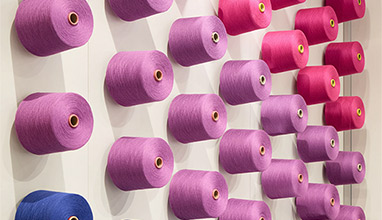Made-To-Order and Made-to-Measure - the new fashion formula in men's suit market
"Menswear retailers can reduce investments 25 times and increase profits", said Martin Yordanov, CEO of Richmart men's suits factory.
How men's suits retailers to increase their profits?
How to raise the ROI?
How to reduce investments significantly?
How to meet the market demand?
How to present a wide variety of models in stores?
How can designers create permanently?
How to avoid obsolete products?
How to expand your business without investments?
How the customer to be sure that his garment is unique?
Made To Order - the answer to all these questions. The Made To Order system will help fashion industry to get out of the crisis and will restore many work positions in European factories.
In the beginning of 2015, Richmart - the most modern menswear factory in Europe - run a new production line Made To Order.
Made To Order is a new kind of process for orders, production and supply of men's suits.
In this system stores can order new suits every week in unlimited quantities and production cycle 2 to 3 weeks. This allows stores to meet demand in every moment.
Richmart organizes its Made To Order processes, using new CAD/CAM systems for orders processing, 24 cutting robots /the ordinary manufacturing needs just 2 robots/ and new production lines by Brisay, Durkopp and Baisler.
Richmart keeps more than 1,000 items in stock - fabrics from world famous mills like Cerutti, Vitale Barberis Cononico, E.Thomas, Dormeuil - and offers over 300 different designs of men's suits, coats, jackets and vests /for different markets and age groups/.
1,000 fabrics, 300 designs and models available in all sizes, needed in a store, give a huge number of options, which can't be kept in a single store. Richmart factory can deliver the orders in 2 to 3 weeks and this leads to much smaller investments from the retailers and driving more sales.
Made To Order gives the chance to sell even more than the planned 10,000 garments during the season, because supply meets the actual demand and no products will have to be put on sale at the end of the season.
Made To Order gives the designers the opportunity to permanently create new designs and put them on the market immediately - not just twice a year (Spring-Summer and Fall-Winter collections). This doesn't give the competitors the chance to copy the models and customers can be sure that their garments are unique.
The whole process is organized upon the principles of Eliyahu Goldratt's Theory of Constraints and is explained in his books 'The Goal', 'Critical Chain', 'Isn't it obvious', 'The choice', etc.
These principles are incorporated in many industries such as electronics, automotive, furniture industry, etc. They make it possible to implement an ambitious goal - in five years the company profit to be equal to today's turnover, without the need of significant investment.

The 'Out of stock' problem
Every company tries to optimize its organization in different ways - by reducing transport costs or finding cheaper suppliers, for example - but these improvements can not provide a profit equal to the turnover. The right decision is studying the deficit and the percent of out of stock items. Very rarely stores have an accurate picture of the scale of this deficit. They believe that it is about 30%. How much money do they lose because of the out of stock products? The result of missed sales is much bigger than this percentage - lost sales may reach 50%. In fact, the amount that is wasted because of deficit is equal to actual sales. This statement gives a great potential. Missing products are deleted from nomenclature and the lost profit becomes invisible. Losses, because of the missing items in stores and the missing items in warehouses should be cumulated. And the result: lost sales are equal to or even bigger than the total accomplished sales.
The life of the fashion items is 6 months long. The fashion business is based on two seasons. Stores give an order, which is big enough to cover the 6 month period, but if one item is over in the end of the first month, the loss is the missed sales in the next five months - that means that the lost sales are 5 times bigger than the real sales. And how many items will be out of stock in one, two or three months? We don't know the exact amount, but this is a significant lack.
The conclusion: If the company finds a way to eliminate deficits, the company will increase its net profit.
But why this is not realized and the industry is developed in the way it is? Because manufacturing factories have imposed restrictions on the size of orders and the period of production and supply. The problem is the specific and culture in fashion industry - products are offered on the market in just two season (Spring-Summer and Fall-Winter) and the time from the creating of the design to the delivery in the stores is one year. Designers should choose fabrics for their Spring-Summer collection in January or February of the previous year.
The 'Final Sales' problem
The fashion industry loves to mask painful problems. Everyone believes that the out of stock items are a positive element, but they are actually a negative one, because they cause the biggest sales losses. Obsolete products do not exist in the fashion industry. Final sales are made, offering 30 to 70% reduction in prices. Final sales start one or two months before the end of the season. The amount of obsolete products is 30%, which is a serious thing.
In fact, this is what happens in stores: there is a 30% deficit in some products, while others have 30% reminder that can't be sold. The reason for this is that the products are ordered long before the start of the season and no one can actually predict the demand for each item.
The 6 months forecast can never be exact - it is not a reasonable assumption. Can we do something about it? Yes, we can leave the illusion that we know what will happen in the future. So, how should we work, taking in mind that the future demand is unknown? And when can we receive a truthful information about the actual demand? 2 weeks after the beginning of the season - but then it is too late for production. Is it, really? What would happen if delivery period is very short? Here comes Made To Order. Now, it takes 6 months, but why? If a suit is produced for 3 hours, why does it take so long to get to the store? Forecast quantities for the whole season are ordered to manufacturers at once, instead of ordering smaller quantities in shorter periods of time.
If factories manufacturing garments work with smaller batches, this will make the production more expensive, but the increase of costs for smaller batches and more frequent deliveries is insignificant compared with the missed sales. Made To Order reduces the deficit to a minimum and eliminates obsolete products.
The Theory of constraints says that if the end user (customer) does not make a purchase, no one in the supply chain has made sales. Every part of the supply chain should monitor the actual demand of the end customer /textile factory → suit's factory → brands → stores/.

Anomalies in the sales process:
-
In the traditional situation, the reserve of ready production in storehouses is for the whole season (6 months), while with Made To Order system, stores have to keep only products, which are needed for the next one week, including full showcases and full stands;
-
Calculated price discounts are made on the base of the ordered garments in one order, but they should be made based on the sales for the whole season;
-
With the Made To Order system, stores can make orders every week, which motivates them to sell more and receive bigger discounts from the contractor;
-
In the beginning of the season, the store's staff finds out that some garments are not so attractive for the customers as others. And trying to sell more of them, put them on the window to receive more attention from goers. But how many sales do they lose because of this method? It can't be said exactly, but the loses are significant;
-
If a store implements the Made To Order system, it will have much bigger percent of well sold garments. Consultants will keep in mind the best selling products;
-
Currently there are 2 to 4 collections per year (Spring-Summer and Fall-Winter). With the Made To Order system, a store can offer 8/12/18 collections, which will make it more attractive for the customers;
-
Designers will not have problems with the bigger number of collections per year - they will just not create their whole collection at once, but will show new models every month. Currently, a little part of the models, offered by designers reach the stores - because of the orders made much earlier (6 months), stores choose only standard/classic designs;
The implementation of Made To Order system will rise significantly profits and the ROI, it will reduce investments, it will show a huge variety of models in stores, it will allow designers to show their creativity, there will not be any obsolete products, it will give the chance for easy business expanding and will bring satisfaction to the customers.
References:
-
Eliyahu M. Goldratt, Jeff Cox. The Goal: A Process of Ongoing Improvement. (1984). North River Press; 2nd Rev edition (1992). ISBN 0-88427-061-0; 20th Anniversary edition (2004) 0-88427-178-1
-
Eliyahu M. Goldratt. It's Not Luck. (1994) ISBN 0-88427-115-3
-
Eliyahu M. Goldratt. Critical Chain. (1997) ISBN 0-88427-153-6
-
Eliyahu M. Goldratt, Eli Schragenheim, Carol A. Ptak. Necessary But Not Sufficient. (2000) ISBN 0-88427-170-6
-
Eliyahu M. Goldratt. Late Night Discussions on the Theory of Constraints. (1998) ISBN 0-88427-160-9
-
Eliyahu M. Goldratt, Ilan Eshkoli, Joe Brownleer. Isn't It Obvious? (2009) ISBN 0-88427-178-1
-
Eliyahu M. Goldratt and Robert E. Fox. The Race. (1986) ISBN 0-88427-062-9
-
Eliyahu M. Goldratt. Essays on the Theory of Constraints. (1987) ISBN 0-88427-159-5
-
Eliyahu M. Goldratt. What is this Thing Called Theory of Constraints. (1990) ISBN 0-88427-166-8
-
Eliyahu M. Goldratt. The Haystack Syndrome: Sifting Information Out of the Data Ocean. (1991) ISBN 0-88427-184-6
-
Eliyahu M. Goldratt. Production the TOC Way (Revised Edition). (2003) ISBN 0-88427-175-7
-
Eliyahu M. Goldratt and Efrat Goldratt-Ashlag. The Choice (2008) North River Press; ISBN 0-88427-189-7 Revised edition (2010) North River Press; ISBN 0-88427-193-5
Hits: 61809 | Leave a comment























